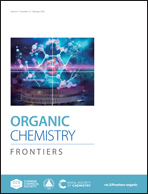Gold catalyzed spirocyclization of 1-ene-4,9- and 3-ene-1,7-diyne esters to azaspiro[4.4]nonenones and azaspiro[4.5]decadienones†
Abstract
A synthetic method for the efficient preparation of a structurally diverse range of spirocyclic pyrrolidines and piperidines, which relies on the gold(I)-catalyzed spirocyclization of 1-ene-4,9- and 3-ene-1,7-diyne esters, has been developed. For substrates containing a terminal alkyne moiety, the reaction was shown to proceed via a tandem 1,2- or 1,3-acyloxy migration/Nazarov cyclization/5-exo-dig cyclization/1,5-acyl migration pathway to provide the azaspiro[4.4]nonenone ring system. In the case of substrates with an internal alkyne substituent, the reaction was found to proceed via a cascade 1,2- or 1,3-acyloxy migration/Nazarov cyclization/6-endo-dig cyclization/1,5-acyl migration pathway to give the azaspiro[4.5]decadienone derivative. The suggested spirocyclization mechanism is the first example of accessing two members of the family of compounds containing an all-carbon quaternary center from an acyclic precursor. It is also a rare instance of intramolecular trapping of a 1,3-cyclopentadienyl intermediate generated from the cycloisomerization of a 1,3-enyne ester with an appropriately placed tethered alkyne functional group. The synthetic utility of this divergent catalytic protocol was demonstrated by its applicability in the spirocyclization of all-carbon or O-tethered substrates and access to a variety of spirocyclic cyclopentane and furan derivatives. It was further exemplified by the late-stage modification of an array of structurally complex natural products and drug molecules under mild reaction conditions at room temperature.
![Graphical abstract: Gold catalyzed spirocyclization of 1-ene-4,9- and 3-ene-1,7-diyne esters to azaspiro[4.4]nonenones and azaspiro[4.5]decadienones](/en/Image/Get?imageInfo.ImageType=GA&imageInfo.ImageIdentifier.ManuscriptID=D3QO01655B&imageInfo.ImageIdentifier.Year=2024)


 Please wait while we load your content...
Please wait while we load your content...